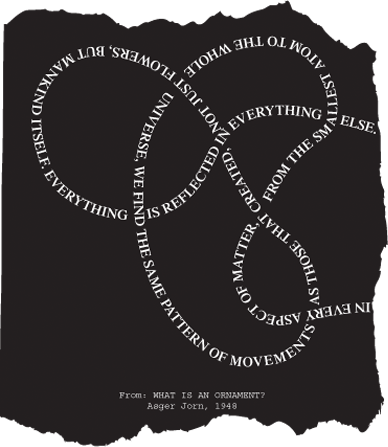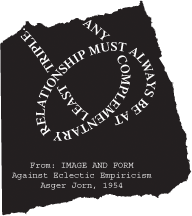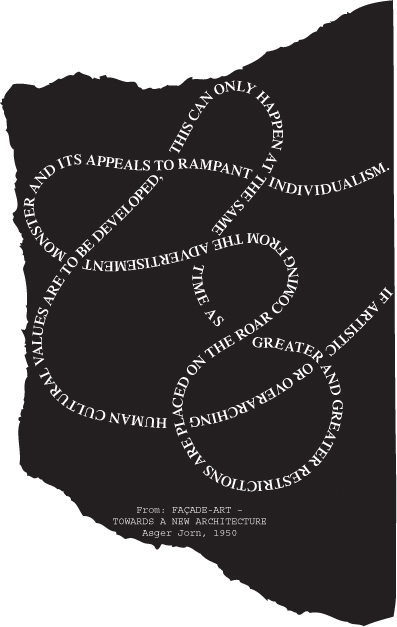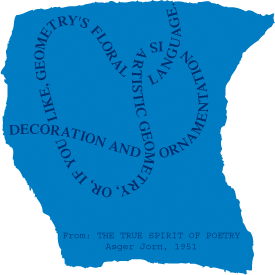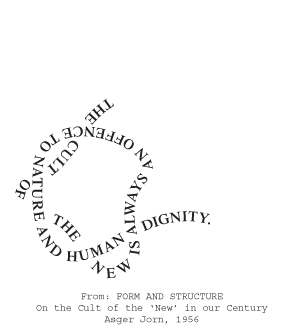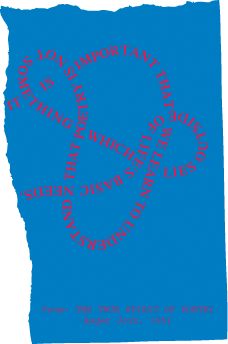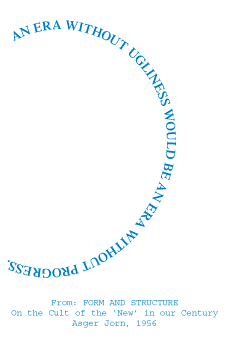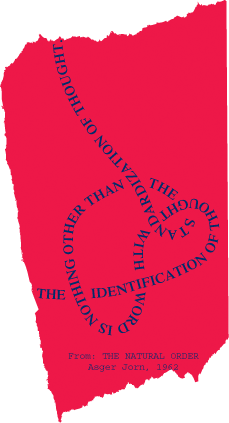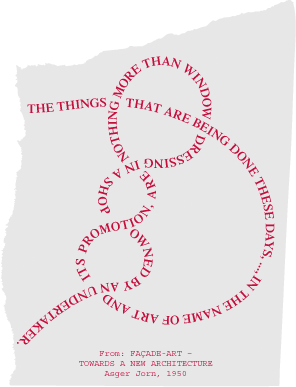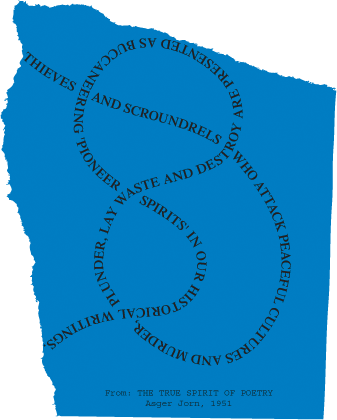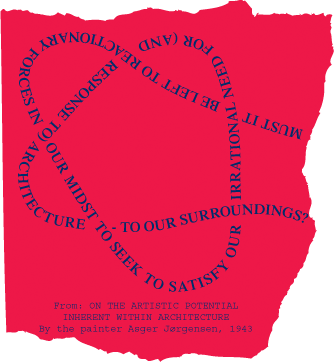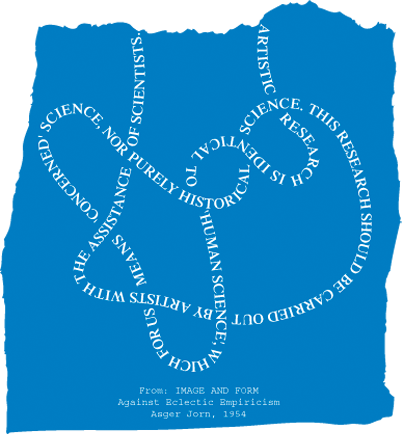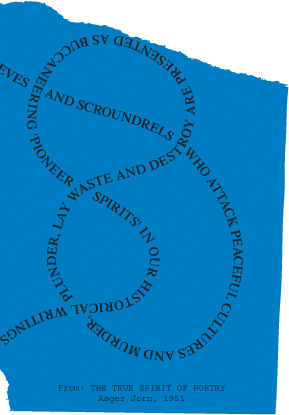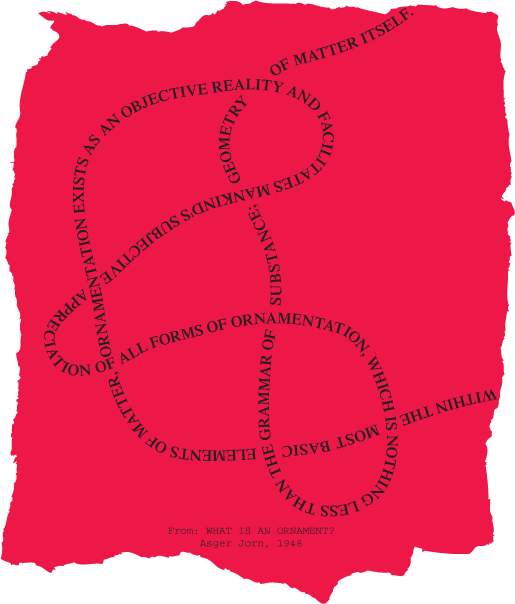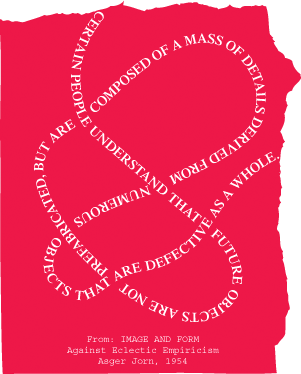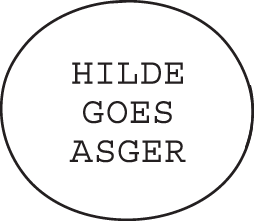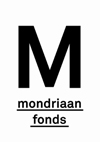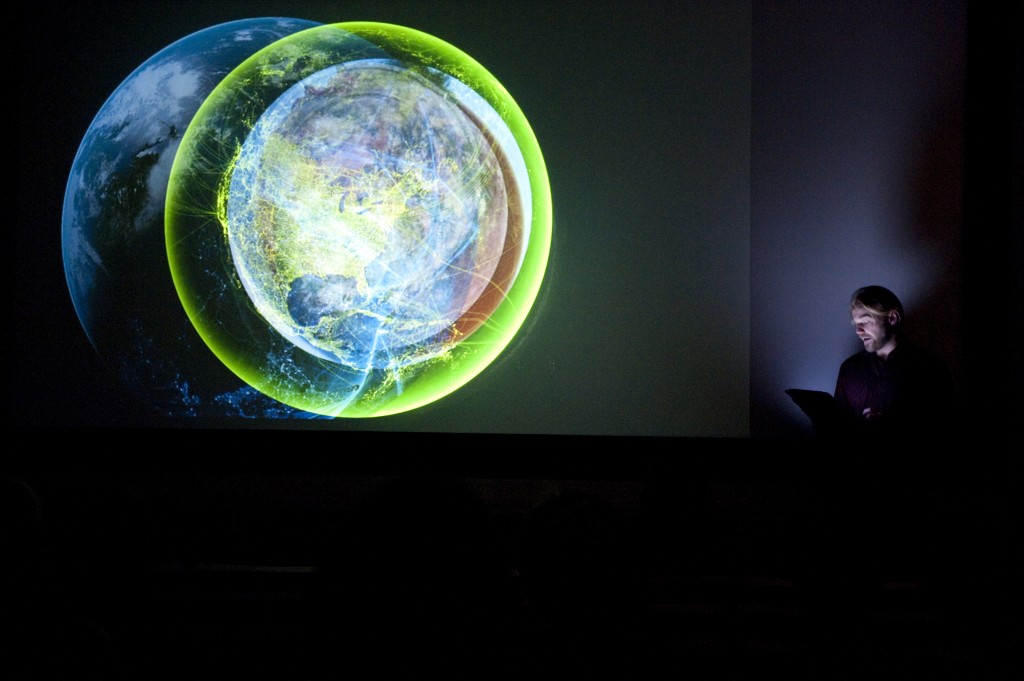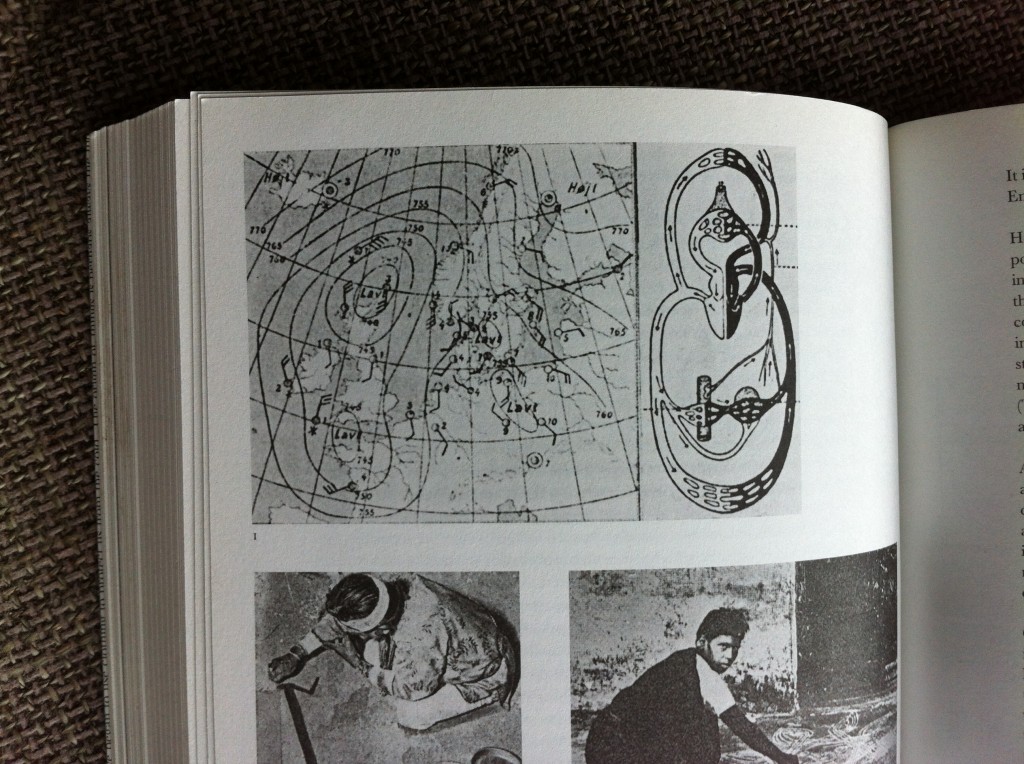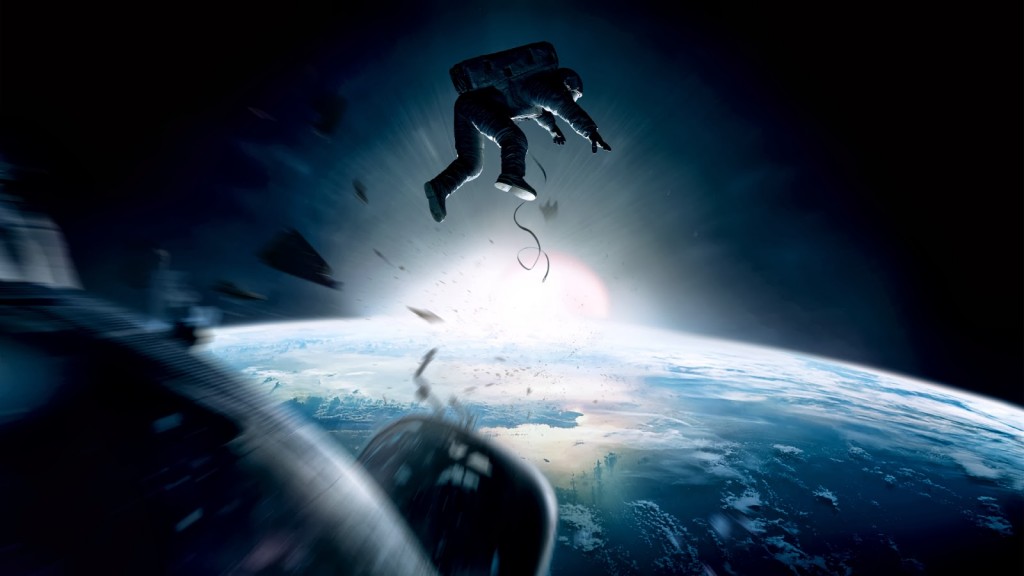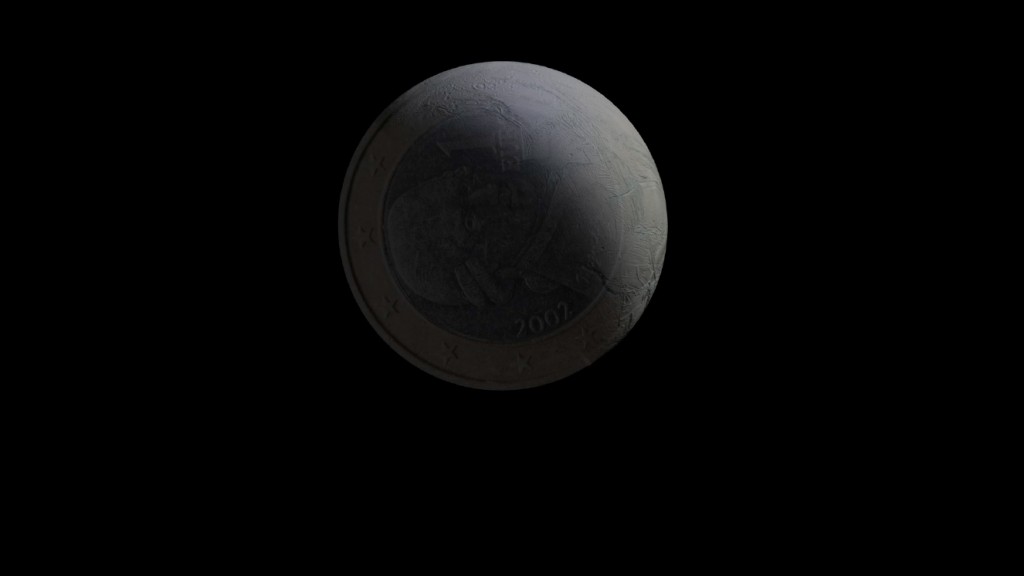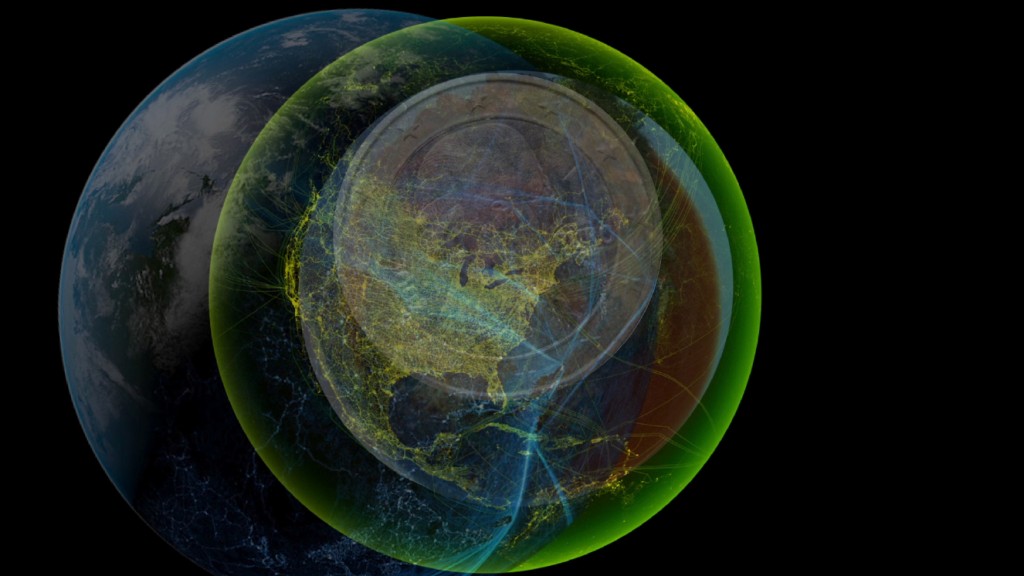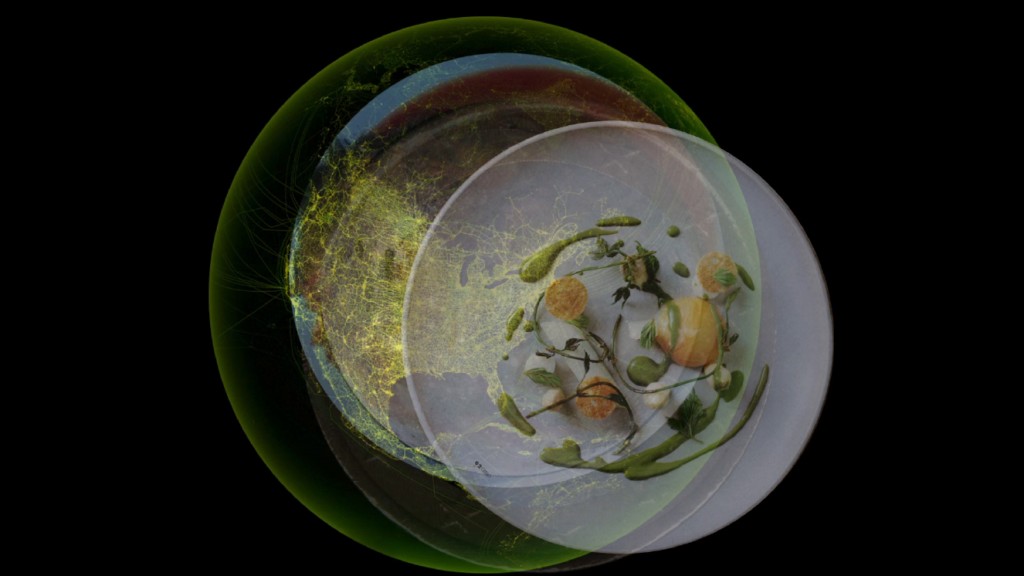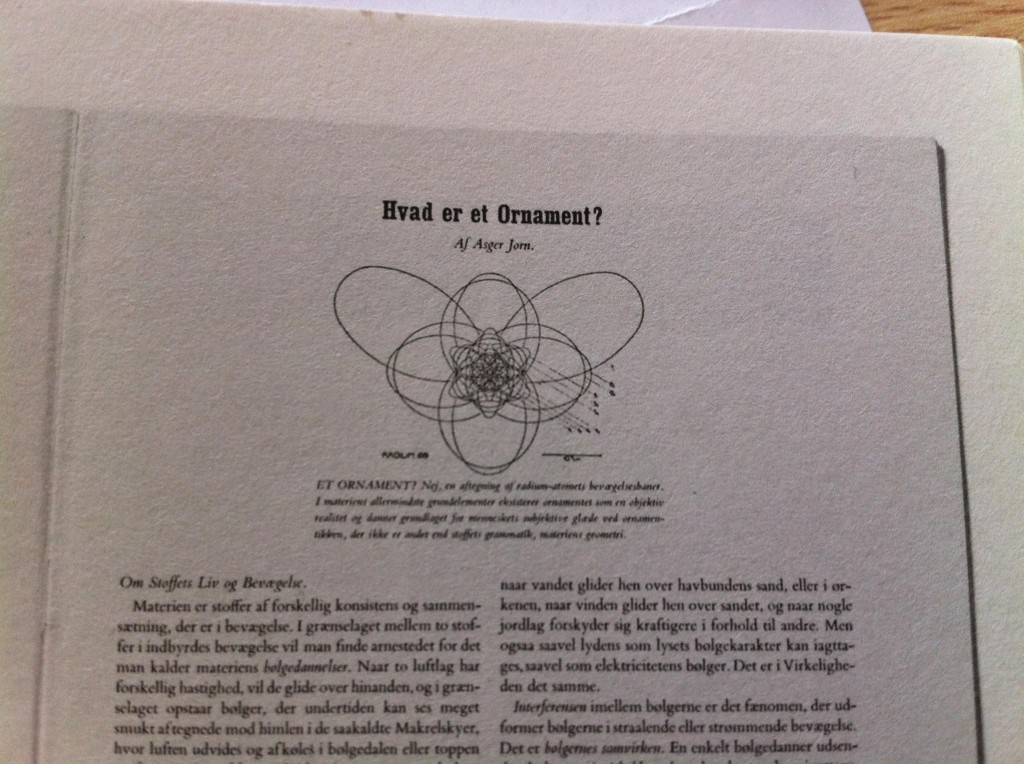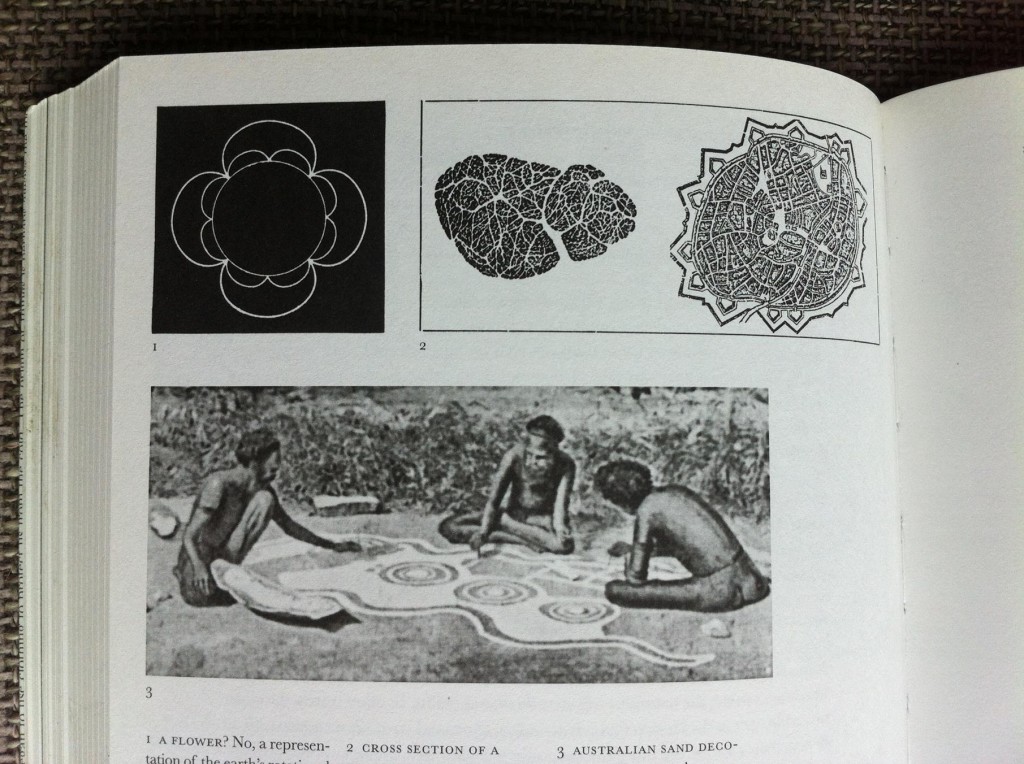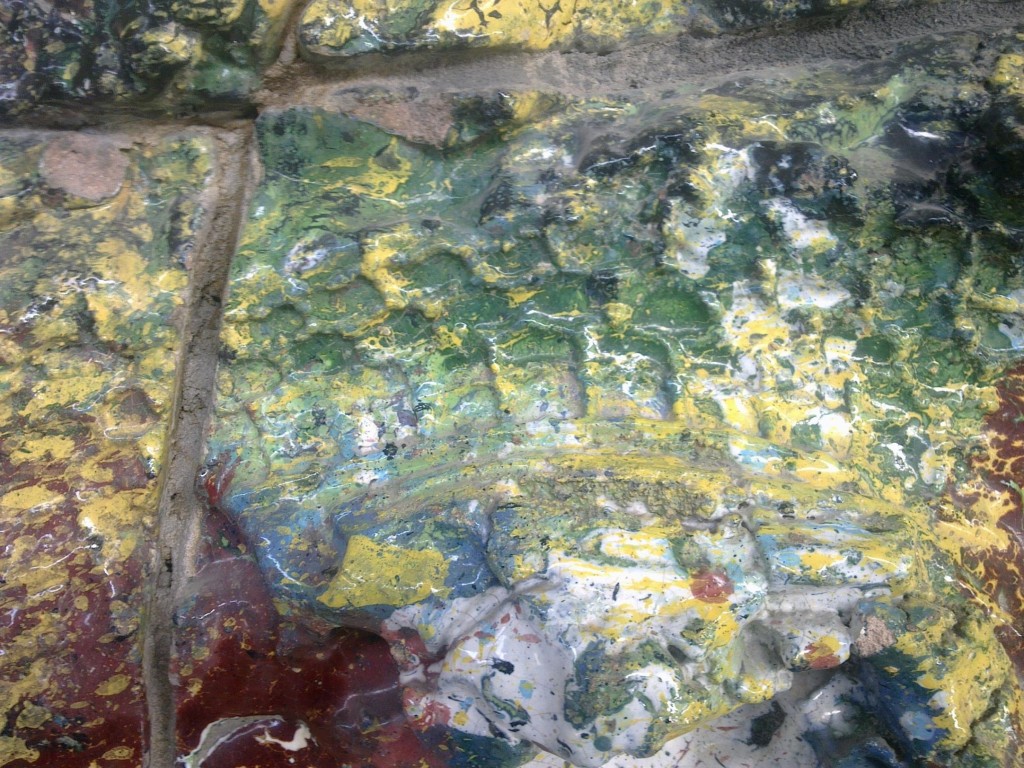THINKING THROUGH MATTER II
Within the framework of my research into Asger Jorn´s writing and thinking I organize public sessions with special guests at a variety of venues. The guest´s practice, knowledge, insights, or responses are informative to my research, or steer the direction I take on a particular topic. The sessions also often respond to the context of the hosting institution, or to a specific request. Making the sessions public is a way to share and enter into a dialogue with the audiences.
‘Thinking Through Matter’ was a talk by myself and Copenhagen-based artist Ferdinand Ahm Krag in the framework of the exhibition ’Asger Jorn – Restless Rebel’ at the Statens Museum for Kunst, Copenhagen. The talk took place Saturday 22 March 2014.
Both my introduction and Ferdinand Ahm Krag’s contribution find their starting point in Asger Jorn´s text ´What is an Ornament?’ from 1948. In this text Jorn states that ornamentation is to be found in all matter, that ornamentation is “the grammar of substance”, “the geometry of life” itself. Illustrations in Jorn’s text include a representation of the orbital paths of a radium atom, and a representation of the earth’s rotational curves within its phases of movement. They serve to stress his idea of the ornament as “spontaneous arabesque”, a type of ‘moving’ and hence dynamic ornamentation that is natural and about organic cohesion.
My text introduces these ideas (a different version though from the session ‘The Grammar of Substance’), and serves as a support to join in Ahm Krag’s thinking about what it means to be ‘natural’ and have a ‘natural’ relationship with materiality in our current times, the age of the anthropocene – the human-made geological epoch. You can find my introduction in the blog entry ‘Thinking Through Matter I’.
In his text ‘What is an ornament’ Asger Jorn describes the ornament as the formal language of nature. Different elements interact in such a way that it becomes ‘ornamental’: think of the patterns the wind and the clouds create. On a micro scale Jorn finds the principle of ornamentation inside the atom. But how far does the principle of ornamentation reach? When does it stop to relate to the human world? In relation to Jorn’s text I am particularly interested to try and locate the outer boundary of the ornament. How far does it stretch? So let us look at the figure of the ornament as a way of assembling a cosmology.
In his ambitious trilogy ‘Spheres’ the philosopher Peter Sloterdijk tries to describe a metaphysical history of “enclosed spaces, utopian or practical pods and domes, real and fantastical atmospheres of ecosystems”. In the first volume he writes: “since the start of the Modern Age, the human world has constantly – every century, every decade, every year and every day – had to learn to accept and integrate new truths about an outside not related to humans.” And he continues: “Every view into the extra-terrestrial spaces provided increasing evidence that mankind is towered above on all sides by monstrous externalities that breathe on it with stellar coldness and extra-human complexity. The old nature of homo sapiens is not up to these provocations by the outside.”
Matter builds up into solar systems that build up into galaxies that build up into clusters and superclusters, and at the very largest scale we find the filament-structures of visible and dark matter – the overall superstructure of the known cosmos. The ornament of matter at the largest scale. Does the natural ornament of matter at a certain point leave the human being behind – and where exactly is this point? And where should we position Asger Jorn in all this? Does he stay within a human centered world?
One could wonder why there are no images of spiral galaxies in Asger Jorn’s text ‘What is an ornament?’ Asger Jorn never leaves planet Earth. It’s from the ground that he looks up and observes the patterns of the clouds and the weather. Today the weather has become climate and the topic of climate change. Climate models always envision the globe seen from outer space. From some thousand kilometers above ground, where there is no gravity. Climate models place us in an imaginary space outside earth and this positioning of ourselves outside earth trying to monitor the climate is made possible by the interior workings of computers. Asger Jorn stays on ground – he stays grounded. But he inhabits the ground in such a way that it seems to be infinite in all directions.
For those of you who have seen the movie ‘Gravity’ – that just won seven Oscars – you will know that the film starts with the following statement: LIFE IN SPACE IS IMPOSSIBLE. ‘Gravity’ is about an astronaut – Dr. Ryan Stone – trying to fight her way out of space and back down to earth. It’s a sort of reversed science-fiction: It’s not about expansion out into Space. It’s about getting back down to earth. Getting grounded and gaining gravity.
It is called ‘re-entry’ when a space-shuttle comes down the atmosphere from outer space. If the film ‘Gravity’ reflects the changing mental state of a culture that now is in the process of a re-entry – a re-entry to the planet and the materiality that makes up the planet, then the question is: what ground are we re-entering? Is it the same ground consisting of the same materiality as when we – metaphorically speaking – took off from the ground in the beginning of modernity ?
If we follow the logic of the film ‘Gravity’ the odd thing is, that it is Earth itself that has become utopia. Not Space. But if it is Earth itself that is the new ´space´ to project our ideals onto, then one might ask: if we are not on earth, then where are we? Apparently we are dealing with this problem of locating where we are?
Marx wrote the following famous words in the communist manifesto: “All fixed, fast-frozen relations, with their train of ancient and venerable prejudices and opinions, are swept away, all new-formed ones become antiquated before they can ossify. All that is solid melts into air.” We are now learning that the ‘air’ Marx mentions is not at all a metaphor. This ‘melting process’ of industrialization and of capitalism has been so profound that it has within the last century led to an epoch-scale crossing of a geological boundary.
If we took off from the planet in the beginning of Modernity we are now in the process of a very troubling and difficult re-entry that brings us beyond modernization. We took off in the geological period called the Holocene – the geological period of time that for 10.000 years provided a safe environmental envelope within which contemporary civilization has developed. Our re-entry to the planet – this re-orientation towards matter, this re-materialization of human thought – is not a re-entry to earth and matter as we know it. It’s an entry to a radically new world. Some geologists have now come up with the term the Anthropocene’. The thesis of ‘the Anthropocene’ suggest that:
“The earth is now moving out of its current geological epoch, called the Holocene and (ii) that human activity is largely responsible for this exit from the Holocene, that is, that humankind has become a global geological force in its own right” – (The anthropocene: conceptual and historical perspectives – Will Steffen, Jacques Grinevald, Paul Crutzen and John McNeill, The Royal Society, 2011)
The starting point of the Anthropocene is set in 1950 by geologists. Jorns text ‘What is an Ornament’ is from 1948 – an interesting coincidence. I would like to bring up one of his interpretations of the ornament again: “The ornament as spontaneous arabesque, which manifests itself as a set of elements within a greater whole. This is ‘moving’ and hence dynamic ornamentation. It is about organic cohesion”.It is my strong feeling that Asger Jorn´s thoughts on the ornament and ornamentation – in some updated version – could be a powerful and necessary contribution to the urgent task of assembling an ecological thought that is not grounded in the Holocene, but instead in the strangely disrupted world of the Anthropocene that goes beyond all former notions of the natural world.
I will now show a video that I recently made and which is partly inspired by Jorns thinking about the ornament. But it also differs a lot from his thinking. My work does not really deal with `organic cohesion`. Instead it is about “digital cohesion”. It is a kind of spontaneous digital primitivism. And the question is – for later discussion – if there still is such a thing as “organic cohesion” that can be used as a model for a materialistic cosmology? How do “organic cohesion” and “digital cohesion” relate to one another?
Ferdinand Ahm Krag, 2014
THINKING THROUGH MATTER (I)
Within the framework of my research into Asger Jorn´s writing and thinking I organize public sessions with special guests at a variety of venues. The guest´s practice, knowledge, insights, or responses are informative to my research, or steer the direction I take on a particular topic. The sessions also often respond to the context of the hosting institution, or to a specific request. Making the sessions public is a way to share and enter into a dialogue with the audiences.
‘Thinking Through Matter’ was a talk by myself and Copenhagen-based artist Ferdinand Ahm Krag in the framework of the exhibition ‘Asger Jorn – Restless Rebel’ at the Statens Museum for Kunst, Copenhagen. The talk took place Saturday 22 March 2014.
Both my introduction and Ferdinand Ahm Krag’s contribution find their starting point in Asger Jorn´s text ´What is an Ornament?’ from 1948. In this text Jorn states that ornamentation is to be found in all matter, that ornamentation is “the grammar of substance”, “the geometry of life” itself. Illustrations in Jorn’s text include a representation of the orbital paths of a radium atom, and a representation of the earth’s rotational curves within its phases of movement. They serve to stress his idea of the ornament as “spontaneous arabesque”, a type of ‘moving’ and hence dynamic ornamentation that is natural and about organic cohesion.
My text introduces these ideas (a different version though from the session ‘The Grammar of Substance’), and serves as a support to join in Ahm Krag’s thinking about what it means to be ‘natural’ and have a ‘natural’ relationship with materiality in our current times, the age of the anthropocene – the human-made geological epoch. You can find Ahm Krag’s talk in the blog entry ‘Thinking Through Matter II’.
What is an Ornament?
Jorn wrote the article ‘What is an ornament?’ in 1948. The text was up to a large extend stemming from Jorn’s critique on the predominant functionalist architecture of the time. Functionalist architecture, roughly said, means that the design of a building should clearly reflect its purpose. In the area of ornamentation this also generally implied that features which are not necessary for convenience, construction, or propriety, were not desirable.
The famous article ‘Ornament and Crime’ by architect Austrian Adolf Loos from around 1910 has been highly influential in the thinking about ornamentation and functionality. Loos regarded ornamentation as the expression of repressed human drives from the subconscious, and believed that we have to transcend these, in order to culturally progress. Asger Jorn, on the contrary, claimed that ornamentation is a fundamental need of human beings, and that a truly functionalist architecture would acknowledge and address this need. As early as 1943 he wrote: “Must it be left to the reactionary forces in our midst to seek to satisfy our irrational need for (and response to) architecture – to our surroundings?” From: ‘On the artistic potential inherent within architecture’ (By the painter Asger Jørgensen)
One of the aspects that Jorn discusses in ‘What is an ornament?’ is what he calls “the tragic history of the ornament in art” – the fact that in the western world, art itself became split into two categories: high art (also classical art) and low art, which Jorn refers to as “folk/banal or spontaneous art”. In relation to this, he states that there are two different interpretations of the ornament:
- The ornament as monumental decoration which seeks to form a finite whole, and becomes static ornamentation.
- The ornament as spontaneous arabesque, which manifests itself as a set of elements within a greater whole. This is ‘moving’ and hence dynamic ornamentation. It is about organic cohesion.
Examples of static ornamentation are: classicist Renaissance art, and various forms of neo classicism.
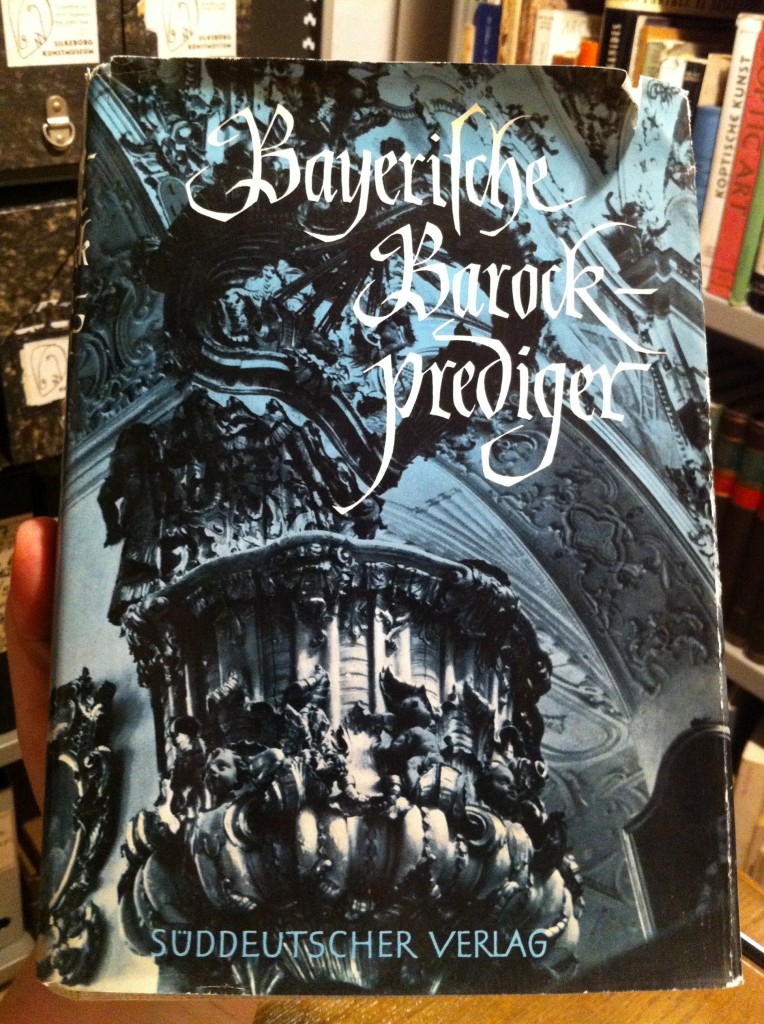
Book cover, 'Bauerliche Barock Prediger', from Jorn's personal library, now at Museum Jorn, Silkeborg
Dynamic ornamentation is to be found in the art forms of all primitive people, art of the Orient, and prehistoric art – until Romanesque monumentalism set in. From that moment on says Jorn, there has been a constant reappearance and disappearance of dynamic ornamentation: Baroque, Rococo, Empire Style, Art Nouveau.
Jorn connects the appearance and re-appearance of both static and dynamic ornamentation to economic and political changes – static ornamentation belonging to classical art, the language of the ruling class, and dynamic ornamentation belonging to spontaneous art, belonging to the people. He also notes that static forms have a tendency to become dynamic because dynamic art “is the natural way of things”.
Ornamentation as the formal language of nature itself
There is however much more to be discovered about Jorn’s text than categorization of ornamentation, or the defence of ornamentation in a critique of functionalism. In fact, the very first point that Jorn makes in ‘What is an ornament?’, is that “Matter consists of substances in motion that have different composition values and consistencies. At the interface between two substances engaged in mutual motion, we find the catalyst for that which we describe as the wave formation of matter.” Think of wind-clouds, wind-sand, sound-light etc. He importantly adds that “this cohesion that exists within the reaction forms inherent in different substances, includes that of mankind.” Jorn illustrates the idea with several images.
The first one he provides with a long caption saying: “An ornament? No, a drawing of the orbital paths of a radium atom. Within the most basic elements of matter, ornamentation exists as an objective reality and facilitates mankind’s subjective appreciation of all forms of ornamentation, which is nothing less than the grammar of substance; the geometry of life itself.”
Jorn’s caption with the first image is: “A Flower? No, a representation of the earth’s rotational curves within its phases of movement. In every aspect of matter from the smallest atom to the whole universe, we find the same pattern of movements as those created, not just flowers but mankind itself. Everything is reflected within everything else.
The second image shows a cross section of the human muscle with right next to it, a map of a town in the Middle Ages. The third images says ‘Australian sand decoration’.
Another article (‘Levende Cultuur’ / ‘Living Culture’) by Jorn, which art historian Graham Birtwistle brings up in his publication ‘Living Art’, starts out in a similar way. Just like in ‘What is an Ornament?’ which was written only a year before, Jorn discusses the arabesque, defining the arabesque as “the expression of movement on all levels”. To Jorn, the arabesque (ornamentation) is the formal language of matter itself. This notion of the arabesque is part of Jorn’s argument for the unity of all life. He says: “All that we know of life is that it is organized movement. All that exists and lives is in movement and forms arabesques in time and space. These arabesques are completely in themselves and yet at the same time they become involved with other arabesques and thereby form organisms; these, in turn, are part of still larger movements which are taken up in that universal movement which we call matter.”
Jorn’s theory of materiality
The fact that Jorn in both ‘What is an Ornament’ and in ‘Living Culture’ starts out defining the ornament as “the grammar of substance, the geometry of life itself”, is indicative for how much the examination and negotiation of the relation between the materiality of the art work and its discursive meanings, between matter and mind in general, meant to him. These issues were of crucial importance in Jorn’s practice. I will discuss his materialist(ic) attitude to life, and would first like to mention art historians Helle Brons and Graham Birtwistle, as their writings which have been very informative to this.
Jorn’s theory of materiality is inspired by thinkers such as Karl Marx, Susanne Langer, Gaston Bachelard, and Niels Bohr – all of whom emphasized – in different ways – the role of physical matter in human thinking. Despite the fact that Jorn was also very critical of some of their ideas, they built an important basis for his own thinking, or re-thinking of matter. This includes thinking about art not as something derived from an ideology or world-view (as Marxist art theory and aesthetics often suppose) but thinking of art as the direct expression of an attitude to life, and as belonging to the fundamental level of work and production. At the basis of his thinking is also the relationship between the visual, the material and the semantic (On an artistic level this means that Jorn’s aim was not a purely visual or material art, but “a recognition of these aspects as meaningful in itself before the discursive level”, as Helle Brons puts it in her paper ‘Material Meanings’), and not in the last place it also includes the thinking of the agency of material matter, the idea that the material world cannot be seen as passive, pre-shaped objects waiting for active subjects to observe and describe. It has its own agency and is constituted partly by its own force and partly by the way we perceive it.
In ‘What is an ornament?’ Jorn expresses this idea the following way: For the materialist artist, “human thought processes are instigated by the substances themselves, and are synonymous with the reaction form which these substances have, because thought (…)cannot avoid the natural laws pertaining to matter. For the material artist, nothing (not even thought processes) can be immaterial in the deepest sense of this word.” In another text, ‘Magic and the Fine Arts’, Jorn also speaks of the identification with things, the identification with matter, when he discusses the importance of play in art and life, and defines play as “the fundamental element in art, the unconscious active enjoyment of life through play with matter, with colours, tones, clay, words etc. (…) Play is not consciously directed to any goal but is a delight, an identification, with things themselves.”(see Birtwistle, p. 76).
Graham Birtwistle discusses the historical roots of Jorn’s ideas on matter at length, mentioning many more names then Marx, Langer, Bachelard and Bohr. Of importance to Jorn’s thinking, at the time of ‘What is an Ornament?’, are for instance also the writings of Erik Lundberg, ideas that Jorn of course adapted. Lundberg’s writings made Jorn think about a new, different way to read pictures, a more ‘simultaneous’ way. Lundberg mentions Persian art and architecture as example of a wholeness that is achieved in a way different from logical construction or accumulation (Gestalt, an immediate coherent whole). These ideas built for Jorn a starting point for a new materialistic theory of unity in art and design, a topic that he also addresses in ‘What is an Ornament?’. In the very last paragraph, where he speaks of the importance to involve artists in the design of working environments, Jorn says: “what is needed here, is nothing other than life, a living environment, social living, a living rhythm of work, a meaningful cohesion to life and a real purpose to one’s work.”
Birtwistle also goes into the influence of nineteenth-century Swedish poetry and other nineteenth-century (Romantic) thinkers on Jorn’s view of (material) life as essentially harmonious. Jorn: “nature, in distinction to class-society is not static or determined by conflict or dualistic but quite the opposite: it is dynamic and harmonious.” (Birtwistle, p. 61) summarized Jorn’s perspective the following way: “Man’s original sense of unity with animal life has been changed to enmity as a result of class-society and its warped values, so that the concept of animality has come to be associated with diseased and decadent human actions rather than with authentic natural values”.
Romantic thinking also led Jorn to reformulate the idea of realist art. In ‘What is an Ornament?’ he states that “the materialist acknowledges that as a human being he is part of the materials and substances, can not be separated from nature.” Consequently, the naturalist artist “tries in vain to transform canvas and oil into (for instance) a lifelike street by trying to conceal the true nature of the material he is using” whereas for the materialist artist, “a line is the track a certain substance leaves behind as it passes another substance.” Obviously, Jorn sees another task for true realist art than to depict the world as we see it in a one-to-one, ‘scientific’ way. Art has a different task, and is able to create a full or even fuller relationship with the world by incorporating subjectivity and romanticism. Jorn (in Birtwistle): “our definition of art as the expression of mankind and his interests, as the expression of subjectivity, simply means that we must see romanticism as the natural and the only genuinely realistic art, because it issues from the subjective, from the needs of mankind …”. Jorn however made clear that this is not about “the hysteria of individualistic romanticism”, but as Graham Birtwistle phrased it: “Jorn invests ‘romanticism’ with his own conception of value, he uses the term to point to the value of a more immediate, undifferentiated kind of experience in distinction to reflective and scientific thought …”
New materialism and post-humanism
In ´What is an ornament?´ Jorn clarifies what it means to be a materialist artist and states that “the materialist acknowledges that as a human being he is part of the materials and substances, can not be separated from nature.” With remarks like these, Jorn’s approach to substance and the material world at times seems remarkably non-hierarchical. This attitude is not only expressed in words, but also in his works, be it in the way he dealt with the materiality of the work, or with the subject matter.
In Jorn’s view, man is not only part of the organic world, man is also an animal, and “subject to the laws the whole organic world has in common.” This rejection of a pure humanist perspective, the idea that we stand above the animal world because we are rational, had much to do with the direct experience of World War II. Jorn, and many of his fellow artists at the time, felt that the experience of (two subsequent devastating) wars had proved this idea to be false. Jorn believed that there is an animal side in humanity that can’t be controlled and also doesn’t want to be controlled.
This doesn’t mean that Jorn didn’t distinguish for instance between man, and nature. He in fact devoted a great deal of attention to the relationship between nature and culture. In his text ‘Luck and Chance’ he writes: “Nature is a subject and has created and evolved itself from within. Nature has no hands and cannot put anything together. But the human being can.” (‘The Natural Order and Other Texts, trans. Peter Shield, London: Ashgate, 2002). In ‘Magic and the Fine Arts’ he even speaks of the superiority of humanity, stating: “It is the task of science to extend our knowledge but it is the task of art to create sensory experiences which answer our needs to form and cultivate the material characteristics we like. It is the capacity to conduct this process ourselves which has made humanity superior to all other animals, which must exist simply in the acceptance of the conditions given them by an inexorable nature.”(Birtwistle, p. 74)
Jorn emphasized that art is not a representation, a mirror, of nature, but that it changes matter, and hence is a direct transformation of nature. Good art, according to Jorn, changes matter in such a way that it becomes more advantageous for humanity, and cultivates the best characteristics in man by its ability to affect and stimulate people. In Jorn’s text ‘Luck and Chance’ it also becomes obvious though, that the fact that man can create tools, and form and cultivate material, transform nature into culture, doesn’t necessarily lead up to overseeable future scenarios. Jorn writes:
“(…) The human being’s changing of natural forms and natural sequences has evolved with incredible speed, and will result in nature, as it functioned before human intervention, being replaced by a new nature.” And a furtheron he says: (…) This utilization of the tool is the point of departure for human art, culture and technique, and creates an opponent relationship between nature in and around us and our wider modes of action. We came into conflict with the whole order of nature.
I would say though that Jorn himself definitely lived up to his own ideas on materiality and his ideas on a new type of ‘realism’ in art (that is more in synch with the ‘natural’) while re-building two small ruined houses that he bought in the municipality of Albissola, Italy, where he lived on and off from the mid 1950’s to his death in 1973. Here, he put his idea of ‘a living art’ into practice, resulting in a situation in which art, architecture and nature merge into what Guy Debord came to call Jorn’s “architecture sauvage” (wild architecture).

House Museum Asger Jorn, Albissola Marina, 2013. Courtesy: Comune di Albissola Marina/MuDA Museo Diffuso Albisola
In relation to this Graham Birtwistle beautifully writes: “In Jorn’s theory, art, poetry, play are firmly rooted in materialistic values but they are described in terms of heightened and intense subjectivity, and it is precisely in this that Jorn locates the social effort of art. (…) Inspiration and enchantment mean for Jorn that external conditions are in tune with our physical and psychic needs; this, the cultivation of man’s relation with life, is ‘the natural goal of all art’ and without this inspiration the earth becomes ‘a vale of tears’. (…) From the energy and vibrancy of life he derives a ‘moral’ imperative for ‘living art’ and ‘living culture’ and offers this as an authentic materialist perspective on the significance of art for society.”
I would like to link Jorn’s eye for and celebration of “the vibrancy of life” to contemporary thinking about materialism. Philosopher Jane Bennett for instance stresses the urgency to rethink “the idea of matter as passive stuff, as raw, brute, or inert” in her publication ‘Vibrant Matter – a political ecology of things’ from 2010. Vitality, the key word in her book, is explained by her as “the capacity of things – edibles, commodities, storms, metals – not only to impede or block the will and designs of humans, but also to act as quasi-agents or forces with trajectories, propensities, or tendencies of their own.” In the book she challenges the notion of a world divided into ‘dull matter (it, things)’ and ‘vibrant life (us, beings)’, and points at the vitality of matter and the lively powers of material formations, such as the way omega-3 fatty acids can alter human moods or the way our trash is not “away” in landfills but generating lively streams of chemicals and volatile winds of methane as we speak. Bennett advocates a revision of the classical notion of ‘ecological’ needs. We should no longer focus on for instance stable interdependencies between species, but think of ecology (and consequently of politics) in a more ‘vitalist’ sense that de-privileges humans.
In her recent paper ‘Material Meanings’, Helle Brøns points at a link between Jorn’s conception of matter and theory formulated by contemporary “New Materialisms” and especially that of physicist and feminist theorist, Karen Barad. Like Jorn, says Brøns, “Barad also builds her theory on Niels Bohr’s work. Both Jorn and Barad, describe a world where objects and subjects – matter and meanings – co-emerge into a unitary field of existence. As Barad puts it “We are not outside observers of the world. Nor are we simply located at particular places in the world; rather, we are part of the world in its ongoing intra-activity.” Jorn similarly imagines: “a plastic world picture which includes and explains all the elements of nature in a unity of time and space in unceasing transformation, where constants are only metamorphoses.“”
Our dealings with matter and processes of materialization, our divisions between the human and the world – between subject and object – have had serious consequences for our actual (which is to say ecological) world. Or, to stay closer to Jorn’s vocabulary, our capacity to shape matter has indeed resulted in “nature, as it functioned before human intervention, being replaced by a new nature”
Jorn’s ‘new nature’ is currently described as no less than a whole new geological era, the antropocene. In the blog entry ‘Thinking Through Matter II’ Ferdinand Ahm Krag talks about what it means to have a ‘natural’ relationship with materiality in this human-made geological epoch.
